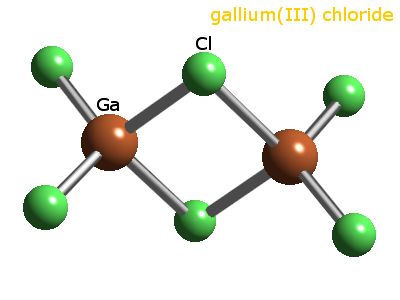Digallium hexachloride
- Formula: Ga2Cl6
- Hill system formula: Cl6Ga2
- CAS registry number: [13450-90-3]
- Formula weight: 352.162
- Class: chloride
- Colour: white
- Appearance: crystalline solid
- Melting point: 78°C
- Boiling point: 201°C
- Density: 2470 kg m-3
The following are some synonyms of digallium hexachloride:
- digallium hexachloride
- gallium(III) chloride
- gallium chloride
- gallium trichloride
The oxidation number of gallium in digallium hexachloride is 3.
Synthesis
2Ga + 6HCl (200°C) → 2GaCl3 + 3H2
Gallium(III) chloride can be made by direct reaction between the elements but hot gallium reacts with hydrogen chloride gas to form gallium(III) chloride in a reaction that does not require the use of chlorine gas. The product sublimes away and the yield is nearly quantitative based upon gallium. The product is a hygroscopic white crystalline solid whose m.p. is 76°C. It sublimes easily under reduced pressures below the melting point.
Solid state structure
- Geometry of gallium: 4 coordinate: tetrahedral
- Prototypical structure:

Element analysis
The table shows element percentages for Ga2Cl6 (digallium hexachloride).
| Element | % |
|---|---|
| Cl | 60.40 |
| Ga | 39.60 |
Isotope pattern for Ga2Cl6
The chart below shows the calculated isotope pattern for the formula Ga2Cl6 with the most intense ion set to 100%.
References
The data on these compounds pages are assembled and adapted from the primary literature and several other sources including the following.
- R.T. Sanderson in Chemical Periodicity, Reinhold, New York, USA, 1960.
- N.N. Greenwood and A. Earnshaw in Chemistry of the Elements, 2nd edition, Butterworth, UK, 1997.
- F.A. Cotton, G. Wilkinson, C.A. Murillo, and M. Bochmann, in Advanced Inorganic Chemistry, John Wiley & Sons, 1999.
- A.F. Trotman-Dickenson, (ed.) in Comprehensive Inorganic Chemistry, Pergamon, Oxford, UK, 1973.
- R.W.G. Wyckoff, in Crystal Structures, volume 1, Interscience, John Wiley & Sons, 1963.
- A.R.West in Basic solid state chemistry Chemistry, John Wiley & Sons, 1999.
- A.F. Wells in Structural inorganic chemistry, 4th edition, Oxford, UK, 1975.
- J.D.H. Donnay, (ed.) in Crystal data determinative tables, ACA monograph number 5, American Crystallographic Association, USA, 1963.
- D.R. Lide, (ed.) in Chemical Rubber Company handbook of chemistry and physics, CRC Press, Boca Raton, Florida, USA, 77th edition, 1996.
- J.W. Mellor in A comprehensive treatise on inorganic and theoretical chemistry, volumes 1-16, Longmans, London, UK, 1922-1937.
- J.E. Macintyre (ed.) in Dictionary of inorganic compounds, volumes 1-3, Chapman & Hall, London, UK, 1992.
